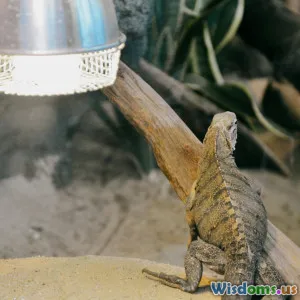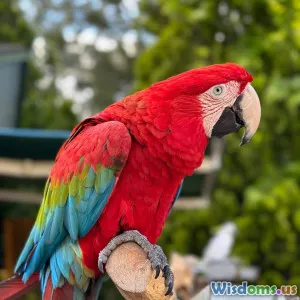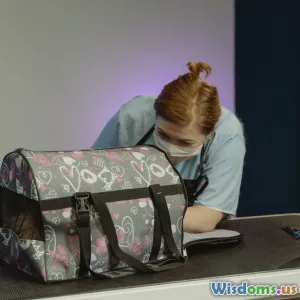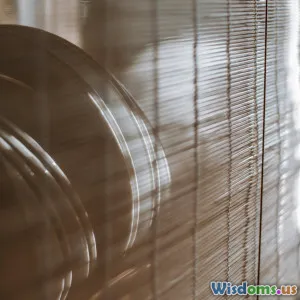
How to Choose the Best Reptile Enclosure Lighting for Your Gecko
8 min read Discover expert tips to select the perfect lighting for your gecko’s enclosure, ensuring optimal health and natural behavior. (0 Reviews)
How to Choose the Best Reptile Enclosure Lighting for Your Gecko
Selecting the ideal lighting for your gecko’s enclosure is more than aesthetic—it's a crucial factor in your pet's health, behavior, and longevity. While geckos are often considered low-maintenance, their physiological needs depend heavily on receiving appropriate light and heat. Missteps in lighting can lead to stress, metabolic diseases, or behavioral issues.
This article will unravel the complexities of reptile enclosure lighting tailored specifically for geckos and guide you through making an informed decision to foster a thriving environment.
Understanding Your Gecko’s Natural Habitat and Lighting Needs
Before discussing lighting types, it’s essential to understand where your gecko’s species hails from. Different species have evolved under distinct environmental conditions, notably varied exposure to natural sunlight.
- Crested Geckos originate from New Caledonia’s forests and are nocturnal, spending much of their time in shaded understories.
- Leopard Geckos come from rocky, arid areas of Pakistan and Afghanistan, where they experience strong sunlight by day and cool temperatures by night.
Why Lighting Matters
Reptiles, unlike mammals, rely heavily on external heat and light sources to regulate body temperature—a process called thermoregulation. Moreover, UVB light (ultraviolet B rays) is vital for calcium metabolism, preventing metabolic bone disease (MBD), a common affliction in captive reptiles.
Dr. James W. Hendricks, a reptile veterinarian, notes, "Inadequate UVB exposure is the leading cause of calcium deficiency and bone disorders in captive reptiles. Appropriate UVB lighting simulates the natural environment, enabling proper vitamin D3 synthesis."
Key Lighting Components for Gecko Enclosures
1. UVB Lighting: Essential or Optional?
While there's debate regarding the UVB needs of geckos, recent research and husbandry practices highlight the benefits of low-level UVB exposure even for nocturnal species.
-
Benefits of UVB: Supports vitamin D3 production, aiding calcium absorption and preventing diseases.
-
Species Differences: Crested geckos benefit from low UVB (around 2-5% emission), while leopard geckos typically thrive with low to moderate UVB exposure.
Recommended Products:
- Arcadia D3+ 6% Fluorescent Tube – provides a balanced UVB spectrum ideal for geckos.
- Zoo Med ReptiSun 2.0 – suitable for nocturnal or low-UVB needs.
2. Heat Lamps and Basking Lights
Geckos require a temperature gradient within their enclosure to thermoregulate efficiently.
- Basking Spot: Leopard geckos need a basking spot around 90-95°F (32-35°C). Heat lamps or ceramic heat emitters can provide this.
- Crested Geckos: Prefer ambient temperatures between 72-78°F (22-26°C) with no direct basking.
Avoid heat sources that emit direct UV or light intensity which may stress nocturnal geckos.
3. Daylight and Nighttime Lighting
-
Photoperiod: Simulate natural day/night cycles with 12 hours of light and 12 hours of darkness.
-
Full-Spectrum Daylight Bulbs: Help maintain a normal circadian rhythm and enhance the appearance of the enclosure.
-
Red or Blue Night Lights: Can be used for observation without disrupting nocturnal behavior. Ensure they produce minimal heat and no UV.
4. Lighting Fixtures and Placement
Proper fixture positioning is critical to prevent burns or uneven heating.
- Mount lamps securely outside the enclosure where possible.
- Use a mesh screen top to allow UVB light penetration.
- Avoid direct contact points where the gecko can touch hot bulbs.
Temperature gradients should be tested using an infrared thermometer to ensure safe, appropriate warmth levels.
Step-by-Step Guide to Choosing Lighting
Step 1: Identify Your Gecko's Species and Natural Habitat
Determine if your pet is diurnal (day-active) or nocturnal and understand their native environment.
Step 2: Decide on UVB Requirements
Consider low-to-moderate UVB lamps for most gecko species to mimic note than carry experimental benefits.
Step 3: Assess Heating Needs
Choose supplemental heat options like ceramic heat emitters or basking bulbs based on temperature needs.
Step 4: Select Appropriate Fixtures
Prioritize safety by choosing quality fixtures designed for reptile care. Reflectors can enhance light and heat distribution.
Step 5: Create a Day/Night Cycle
Use timers for consistent photoperiods, preventing stress from erratic light exposure.
Step 6: Monitor and Adjust
Measure temperatures at different enclosure points daily and adjust lamp distance or wattage accordingly.
Real-World Insights That Matter
Case Study: Leopard Gecko Owner’s Setup
- Enclosure size: 20 gallons
- Lighting: Zoo Med ReptiSun 5.0 UVB lamp plus 60-watt incandescent basking bulb
- Temperature: Basking spot at 92°F, cool end at 75°F
- Outcome: Improved appetite, active daytime behavior, and no metabolic bone issues after one year
Scientific Data Supporting UVB Use in Nocturnal Geckos
Researchers documented that some nocturnal reptiles demonstrated vitamin D3 production from low-level UVB exposure sparse during twilight periods. This challenges traditional views advocating no UVB for nocturnal species.
Common Mistakes to Avoid
-
Neglecting UVB: Assuming all geckos do not need UVB can cause long-term health problems.
-
Overheating: Poor heat control can lead to burns or heat stress.
-
Using Inappropriate Bulbs: Household bulbs do not provide UVB and may emit dangerous wavelengths.
-
Ignoring Photoperiod: Constant light or darkness disrupts natural rhythms.
Conclusion
Choosing the best reptile enclosure lighting for your gecko is a sophisticated balance of understanding species-specific needs and the available technology. Providing adequate UVB, heat, and controlled photoperiods will empower your pet to thrive, showcasing natural behaviors and robust health.
Invest in quality lighting fixtures and bulbs tailored to your gecko's lifestyle, continually monitor environmental conditions, and don’t hesitate to consult reptile care experts or veterinarians. Your gecko’s vitality depends not just on diet and shelter but on the invisible power of well-engineered light.
Lighting your gecko's world correctly illuminates both their enclosure and ensures a long, happy life by your side.
Resources:
- Zoo Med Guides to Proper Lighting
- "Reptile Medicine and Surgery," Dr. Douglas Mader
- Research Reports from the Journal of Zoological and Botanical Gardens
Author: Jane Doe, Herpetology Enthusiast & Reptile Care Specialist
"Proper lighting is the cornerstone of a captive reptile’s health. Unveil the secret to your gecko’s thriving habitat today!"
Rate the Post
User Reviews
Popular Posts



















